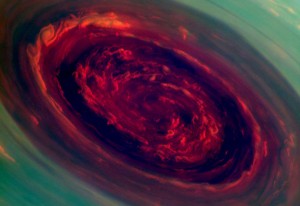Misrepresenting Science: Saturn’s North Pole “Hurricane”
By now, you may have read about the imagery from the Cassini mission to Saturn. The NASA press release calls it a “large hurricane”. The European Space Agency has a similar release.
Nice false-color imagery, yes. But, bad science.
Hurricanes are storms fueled by the release of latent heat from condensing water that is originally obtained from the storm traveling over warm water. Although the term “hurricane” is specific to storms in the North Atlantic Ocean basin that exceed a certain wind speed, the storms are part of a more general classification called “tropical storms”. Their name “tropical storms” tells you something specific about where they form. Obviously warm water is much more common in the tropics on Earth than farther poleward. But, that doesn’t stop storms fueled by the release of latent heat from forming farther north. Medicanes are like hurricanes that form over the warm waters of the Mediterranean. And, there is a class of polar lows that develop mostly due to the release of latent heat. There was even an article published calling them “Arctic hurricanes.”
So, what does this have to do with the Saturn hurricane?
The press release reveals the problems with calling this circulation a hurricane.
The ESA press release admits the storm is not over a water body. I didn’t see the evidence that the storm is fueled by latent heat release, which is the key characteristic of a hurricane. And, the NASA press release says that it is locked to the North Pole.
“We did a double take when we saw this vortex because it looks so much like a hurricane on Earth,” said Andrew Ingersoll, a Cassini imaging team member at the California Institute of Technology in Pasadena.
Just because it looks like the same type of storm on Earth does not mean it is the same. Morphological similarity does not equal dynamical similarity.
Actually, this storm looks like it is embedded within the polar vortex, a planetary-scale circulation driven by the pole-to-equator temperature difference. The polar vortex is a pool of cold air roughly centered on the North and South Poles with the jet stream around the edge. The polar vortex is strongest in the winter.
But perhaps “storm in the polar vortex on Saturn” is not as newsworthy as “hurricane on Saturn”.
On Earth, hurricanes tend to drift northward because of the forces acting on the fast swirls of wind as the planet rotates. The one on Saturn does not drift and is already as far north as it can be.
“The polar hurricane has nowhere else to go, and that’s likely why it’s stuck at the pole,” said Kunio Sayanagi, a Cassini imaging team associate at Hampton University in Hampton, Va.
The fact that it is “stuck” at the pole is further evidence that the scientists are looking at a circulation within the polar vortex. It also ignores the simple fact of why tropical cyclones on Earth travel northward: They often get picked up by waves in the jet stream and brought northward in a process called extratropical transition.
That the North Pole of Saturn was in darkness for so long is consistent with the dynamics of the polar vortex on Earth. The polar vortex is cold core. Hurricanes are warm core. Is the “hurricane” on Saturn cold core or warm core? That is easily determined from radiation emitted from Saturn.
“Scientists will be studying the hurricane to gain insight into hurricanes on Earth, which feed off warm ocean water. Although there is no body of water close to these clouds high in Saturn’s atmosphere, learning how these Saturnian storms use water vapor could tell scientists more about how terrestrial hurricanes are generated and sustained.”
While I wouldn’t begrudge anyone the fascination of studying the atmosphere and its features on other planets, this statement is one of the most over-reaching statements that I’ve ever read in a scientific press release. That we need to look at a some storm on Saturn to understand how Earth’s hurricanes use water vapor is pretty laughable.
I’m not saying that we don’t use analogies to describe our science to the general public. In fact, I’m a big fan of well-crafted analogies that explain scientific concepts to nonscientists. What bothers me is an analogy that misrepresents the scientific understanding, which — as far as I understand this storm on Saturn — is what NASA and ESA are doing by calling this storm a hurricane rather than the polar vortex.
NOTE: Phil Platt’s Bad Astronomy touches upon the fact that it is a polar vortex, but doesn’t go far enough in drawing the distinction between a hurricane and the circulations within the polar vortex.



